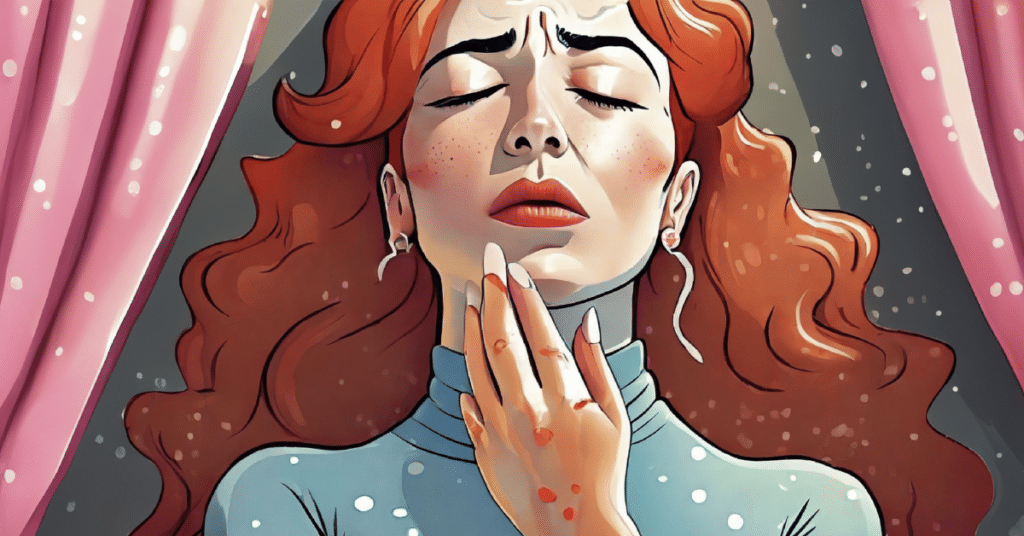Dear Aunt Vadge,
I have histamine intolerance and one of my main symptoms is an itchy clitoris and/or vulva (never the vagina, just the clitoris, and sometimes the vulva) mostly right before my period, and most recently itchy all month long.
My vaginal pH is 5.0, so I wanted a treatment to get the pH and microbiome normal again.
Please help me by recommending a treatment?
Thank you.
Sincerely,
Itchy
Age 42, California, USA
_________________
Dear Itchy,
It sounds like you’re having a really uncomfortable time with this itchiness, which must be very frustrating, especially if it’s been going on for quite a while.
Histamine intolerance can indeed manifest as itchy skin, and the fact that your symptoms worsen around your period is not uncommon due to the hormonal changes that can affect histamine levels.
As for your vaginal pH being 5.0, that is a bit higher than the ideal range of 3.8 to 4.5 for a healthy vaginal environment, which might indicate that your vaginal flora is not at its optimum balance.
First things first, get yourself a comprehensive vaginal microbiome test. Once you’ve got your results back, you will be armed with the information you need to help work out why your pH is sitting at 5, when it should be 4.5 or less.
Share your dashboard with info@myvagina.com and we’ll get your results through at this end to help you further.
Now, while I would love to give you the perfect cure right here and now for your histamine intolerance problems, I must highlight how important it is to work with a healthcare provider to manage your symptoms effectively, taking into account your histamine intolerance and its effects on your body, including your vaginal health.
My Vagina’s practitioners can help you find the cause for the pH shift and itching, which might be due to an imbalance in your vaginal microbiome or a result of the histamine levels affecting your tissues, or perhaps even something else.
Investigations by a trained, experienced practitioner are important, because histamine intolerance isn’t a disease or diagnosis: it’s a symptom of something else happening. Maybe you are allergic to the tree outside your house; maybe you are genetically low in the DAO enzyme that degrades histamine; maybe something completely different.
The reason histamine is high in your system, when it shouldn’t be, is a discussion and requires detective work to work out why, and then address that issue. Then, the problem goes away.
Histamine intolerance is a bad name for what you’re experiencing – it should be called histamine overload. You’re not intolerant to histamine – it’s natural and important – but you have a lot in your system and it’s not able to be degraded as fast as it’s being made. You’ve got a histamine bottleneck.
In the meantime, there are some general tips I can offer to help soothe your symptoms and support a healthy vaginal environment:
- Lactulose and Probiotic Kit: Look into taking a high-quality, vagina-specific probiotic with prebiotic lactulose vaginally, to feed the healthy lactobacilli bacteria in the probiotic. This treatment strategy can help to repopulate your vagina with healthful bacteria, which may help to lower the pH and reduce irritation.
- Low-histamine diet 1 week challenge: If you haven’t already, try following a strict low-histamine diet for one week. This is not a long-term treatment strategy, but a short-term experiment to see if histamines are truly contributing to your vaginal symptoms. Then, you need to work with your practitioner to understand why it’s happening and get appropriate treatment for the underlying causes. Restricting your diet is not advisable for long periods of time without practitioner supervision. Learn more about the low histamine diet.
- DAO enzymes: Take these just before food as directed to suck up histamine from food.
- Aunt Vadge’s Delicate Cuts Cream: This soothing, healing cream may help soothe the itching while you work on other areas of your health.
- Gentle hygiene: Use gentle, unscented products (or just warm water) to clean the vulva and avoid anything that could further upset the balance or cause irritation. Avoid soaps or washes that strip the natural barrier from your skin. No douching.
- Cotton underwear: Wear loose-fitting, cotton underwear and avoid tight clothing to reduce irritation and allow the area gentle air flow and temperature control.
- Cool compresses: Applying cool compresses to the itchy area can provide some temporary relief.
- Oatmeal baths: Oats are very soothing to itchy skin, and a warm bath with an oat pack can be a gentle way to relieve itching.
- Avoid known triggers: If there are certain foods or activities that you know make your symptoms worse, try to avoid them as much as possible as you work on the underlying issues with your practitioner.
- Learn more about histamine and your vagina
Given your specific situation and the persistence of your symptoms, I strongly suggest making an appointment with a My Vagina vulvovaginal specialist practitioner, all of whom have vast experience with histamine intolerance and associated vulvar issues. We are histamine experts.
Your practitioner will provide targeted treatment options, to address the underlying causes of your symptoms, while also alleviating the discomfort. We want your itchiness gone and your pH in the healthy range!
Remember, while over-the-counter and lifestyle measures can help manage symptoms, your situation sounds like it needs a professional eye to pinpoint the best course of action.
Take care, and here’s to less itch and more comfort!
Best wishes,
Aunt Vadge
The most comprehensive vaginal microbiome test you can take at home, brought to you by world-leading vaginal microbiome scientists at Juno Bio.
Unique, comprehensive BV, AV and 'mystery bad vag' treatment guide, one-of-a-kind system, with effective, innovative treatments.
Promote and support a protective vaginal microbiome with tailored probiotic species.






